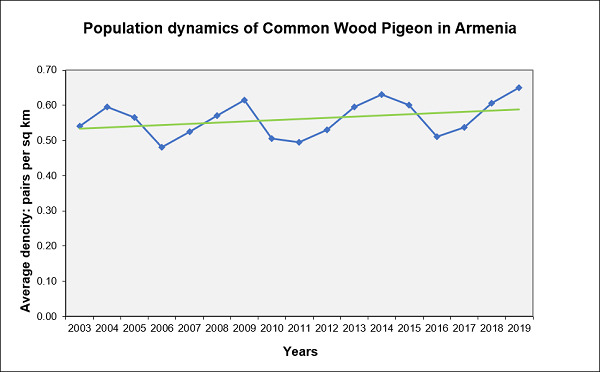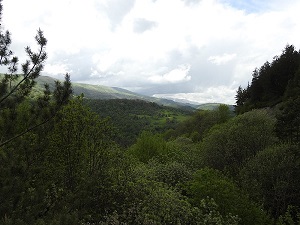The State of Common Wood Pigeon (Columba palumbus Linnaeus, 1758) in Armenia
Aghababyan K., Khanamirian G.
TSE Towards Sustainable Ecosystems NGO, 87b Dimitrov, apt 14, 0020 Yerevan, Armenia
Email: karen.aghababyan@gmail.com
Abstract
The Common Wood Pigeon was monitored in Armenia since 2003. The current population size of that species can be estimated from 14,910 to 21,480 pairs. Its population trend during last decade demonstrates moderate increase. The species could potentially suffer from poor hunting management. Current conservation status of the species can be evaluated as Least Concern. To prevent possible decline of the species it is necessary to set up proper game management and monitoring, supported by strengthening of control over number of shot birds.
Keywords
Common Wood Pigeon, Columba palumbus, Armenia, Conservation status, Population size
Introduction
Common Wood Pigeon is one of the representatives of Columbidae in Armenia, that occupies wide variety of woodlands (Adamyan and Klem 1999, Cramp and Perrins 1993). Meanwhile, it is one of the main game bird species in Armenia, however, unfortunately there is a lack of monitoring of those in the country. The distribution of shooting permits without supplemental monitoring might cause undesired decline of some species. That is why it is necessary to understand the population size of such an important species as Common Wood Pigeon and its population trends. Such knowledge might also become supportive during study of population of raptors, which are feeding on Wood Pigeons, such as Peregrine Falcon, Northern Goshawk, Lynx, and others. Therefore, the current communication is aimed at describing the state of Common Wood Pigeon in Armenia.
Materials and methods
Since 2003 we have started monitoring of breeding birds in Armenia. The monitoring of species, like Common Wood Pigeon was implemented using point counts. Since a 10×10 km square is accepted as a unit of change, the standard European Monitoring Grid 10×10 km was applied to Armenia, and as a result the territory of the republic was divided into 374 squares. Thus, routs and points of count are connected to squares, and each of them was obtaining its own identification number. Data on the species was obtained from two different sources: (1) unstandardized observations (so called opportunistic data) and (2) standardized counts (data, collected according to standard methodology). Both data may be used to create species distribution maps, while the data, collected by second method may be used for estimation of its population trend.
1. Unstandardized observations (opportunistic data) were provided by birdwatchers and contain minimum data requirements: precise identification of species, observation date, geographic coordinates, name of nearest locality (human settlement, mountain, historical site, etc.), breeding code, name of observer and his contacts. The observations have been commented, e.g. time, observation duration, number of people in the group, etc. Since it was not always possible to record precise geographical coordinates on the spot, information sometimes was provided according to 10×10 km square code.
2. Standardized counts (counts conducted within certain time period) have been led by both:
specialists and birdwatchers that have proper skills. Counts were implemented during fixed period of time of 1 or 2 hours, when an observer was passing the route in a slow motion. It was desirable to make such counts at the time of the day, when birds were most active (as a rule, early in the morning). The best season for Wood Pigeon count was considered the period between 1st of April and 30th of May, nevertheless, data collected from end of March and later until June were used as well. With this method, there were more requirements to data: number of observed or acoustically recorded individuals, observation date, geographical coordinates of a beginning and the end of the route, start and end times of the count, breeding code, name and contacts of observer/s. Collected data were entered into standardized protocol and later were inputted into database.
To calculate population trends, we used multi-year data series and process them using TRIM 3.0
software (Van Strien et al. 2004). For the purpose the Collated Index is calculated using log-linear poison regression; then the deviations are calculated and presented as a linear function, showing populations growth or decline. Statistically significant change is stated on the p<0.05 level, otherwise the population is considered stable. The mapping is implemented using ArcGIS 10.0 software. To estimate the threats, we have conducted surveys of those hunters, who hunt regularly, every year. The collected data included: knowledge of the species, how regular the species is hunted, how many individuals of the species are hunted, how that number corresponds to the allowed number, have the hunters been punished for exceeding the allowed number. To get the objective information, we have been conducting the surveys in confidential manner.
Results
Distribution and biological peculiarities in Armenia
As it is demonstrated on the map, the Common Wood Pigeon occupies almost entire Armenia, inhabiting wide variety of woodlands, often nesting next to human in parks and orchards. Particularly, it breeds in riparian woodlands, tree plantations, deciduous and mixed forests, juniper woodlands, mountain steppes with some disperse trees, and so on. In fact, it is not occurring only in deep deciduous forests and subalpine treeless zone. The elevation range taken by the species makes from 375 to 2,200 meters above sea level. Common Wood Pigeon makes its nests on trees, both deciduous and coniferous, placing those from 1.5 to 7 meters from the ground. Beginning of its breeding season strongly depends on the elevation, thus at lower elevation it starts at early to mid-March, while at the high elevation – from early to mid-May.
Fig 1. Distribution map of Common Wood Pigeon in Armenia
Fig 2. Typical habitat of Common Wood Pigeon in Armenia
Population dynamics
According to the last estimation, population of the species makes from 14,910 to 21,480 pairs breeding pairs. Population trend during last ten years demonstrates moderate increase (p<0.05), see the Fig 3. The questioning of the hunters demonstrates, that among 200 surveyed hunters 165 (83%) know the species as a regular game object, 142 hunters (71%) hunt the species regularly, the average daily gain of the species makes 6.07 birds per hunter per hunting day, and that in 62% of the cases the number exceeds the daily hunting quota of the species. None of the hunters have been punished for exceeding of the number of individuals, because they have not been inspected. Therefore, the lack of monitoring of the species’ population and control over the hunting process can result in overuse of the resource, which, in its turn, might cause the decline of Wood Pigeon in future if the approach on management of game bird species in general and Wood Pigeon in particular, would not be drastically revised.
Fig 3. Graph of population dynamic of Common Wood Pigeon in Armenia during 2003-2019
Discussions
Causes of observed population trend
It appears that the species’ increase is supported by two factors: growth of cereals and poor municipal waste management in the country that results on disposing the food remains at the dump sites. Both factors seem to provide enough food supply for the adult and offspring. The illegal hunting out of game season is also minimal, which probably helps the species to produce the high number of offspring. However, it is possible that the lack of monitoring of game species in the country and the poor control over the shot birds can lead to the reverse trend and cause a decrease of the Wood Pigeons in Armenia.
Present and proposed conservation measures
At current the species has not been evaluated for the Red Data Book of Armenia (Aghasyan and Kalashyan 2010), and it is protected in all the protected areas of the country as well is presented in all the Emerald Sites under Bern Convention (Fayvush et al. 2016). Taking into account the current distribution and population trend of the species, its conservation status should be evaluated as Least Concern. Therefore, at current there are no specific conservation measures required. However, it obviously requires improved game bird management and supplemental monitoring to prevent its possible decline due to overhunting. Also, there is a need to strengthen the Inspectorate for Nature Protection and Mineral Resources and possibly develop its cooperation with the Hunters’ Unions in the country.
Conclusions
• The current population size of the Common Wood Pigeon in Armenia can be estimated from 14,910 to 21,480 pairs.
• Its population trend during last decade demonstrates moderate increase.
• The species could potentially suffer from poor hunting management.
• Current conservation status of the species can be evaluated as Least Concern.
• To prevent possible decline of the species it is necessary to set up proper game management and monitoring, supported by strengthening of control over number of shot birds.
Acknowledgements
The monitoring of Common Wood Pigeon in Armenia as well as the study of its biological peculiarities is supported by volunteers – the members of Armenian Birdwatching Association.
References
Adamian M., Klem D. 1999. Handbook of the Birds of Armenia. American University of Armenia, California.
Aghasyan A. and Kalashyan M., eds. 2010. The Red Book of Animals of the Republic of Armenia. Yerevan, Ministry of Nature Protection.
Cramp S.; Perrins C. M. 1993. Handbook of the birds of Europe, the Middle East and Africa. The birds of the western Palearctic vol VII: flycatchers to shrikes. Oxford University Press, Oxford.
Fayvush G., Arakelyan M., Aghababyan K., Aleksanyan A., Aslanyan A., Ghazaryan A., Oganesyan M., Kalashyan M., Nahapetyan S. 2016. In Baloyan S. ed. The “Emerald” Network in the Republic of Armenia. Yerevan. Ministry of Nature Protection.
Van Strien A., Pannekoek J., Hagelmeijer W., Verstrael T. 2004. A loglinear Poisson regression method to analyse bird monitoring data. In: Anselin, A. (ed.) Bird Numbers 1995, Proceedings of the International Conference and 13th Meeting of the European Bird Census Council, Pärnu, Estonia. Bird Census News 13 (2000): 33-39.
Comment of the Editor ( Enrico Cavina ecavinaster@gmail.com )
It was very appreciated the contribute of the Armenian Researchers to inform western researchers about the status of Woodpigeons resident in Armenia in Central Caucasian area close to South Georgia.
The paper shows that many confidential informations come from the Hunters.
We have asked to the Authors what it is the importance ( exchange between migrants and residents) of the migrating birds arriving from North ,and they have so surprising answered :
“We do not know anything about migration of Wood Pigeons through Armenia (even, do not know, whether it exists in the country).”
We think that in the future it could be useful to study better the possible influence of the Migration over the resident population of Woodpigeons in Armenia .
On this way we have asked information to Alexander Mischenko ( Russian Academy of Science) about migrations from Russia to Caucasian area and he has so answered
“Part of the Russian population of Woodpigeon migrates to the North Caucasus in late autumn. Their further movements depend from the winter temperature. In not very cold winters Woodpigeons spend all winter in North Caucasus in Russia (Krasnodar Territory), not far from the Black Sea coast. If a winter is cold and very snowy, they migrate to Georgia, Armenia and sometimes to Turkey. Numbers of wintering Woodpigeon fluctuate in years. In winter 2010/2011 their total number in the North Caucasus was 250 000 – 300 000 individuals. “


